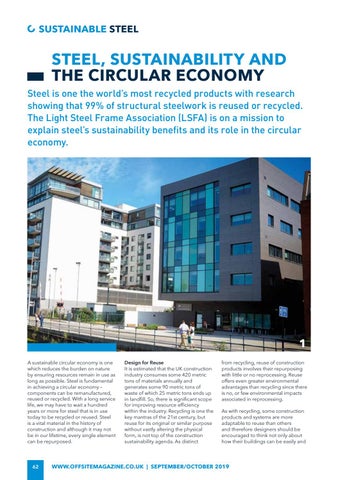SUSTAINABLE STEEL
STEEL, SUSTAINABILITY AND THE CIRCULAR ECONOMY
Steel is one the world’s most recycled products with research showing that 99% of structural steelwork is reused or recycled. The Light Steel Frame Association (LSFA) is on a mission to explain steel’s sustainability benefits and its role in the circular economy.
1 A sustainable circular economy is one which reduces the burden on nature by ensuring resources remain in use as long as possible. Steel is fundamental in achieving a circular economy – components can be remanufactured, reused or recycled. With a long service life, we may have to wait a hundred years or more for steel that is in use today to be recycled or reused. Steel is a vital material in the history of construction and although it may not be in our lifetime, every single element can be repurposed.
62
Design for Reuse It is estimated that the UK construction industry consumes some 420 metric tons of materials annually and generates some 90 metric tons of waste of which 25 metric tons ends up in landfill. So, there is significant scope for improving resource efficiency within the industry. Recycling is one the key mantras of the 21st century, but reuse for its original or similar purpose without vastly altering the physical form, is not top of the construction sustainability agenda. As distinct
from recycling, reuse of construction products involves their repurposing with little or no reprocessing. Reuse offers even greater environmental advantages than recycling since there is no, or few environmental impacts associated in reprocessing. As with recycling, some construction products and systems are more adaptable to reuse than others and therefore designers should be encouraged to think not only about how their buildings can be easily and
WWW.OFFSITEMAGAZINE.CO.UK | SEPTEMBER/OCTOBER 2019
